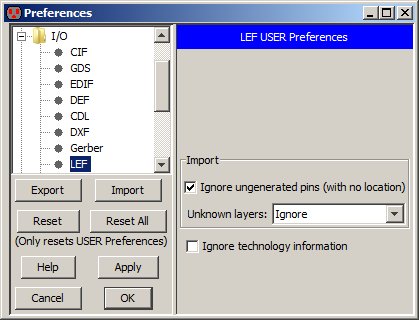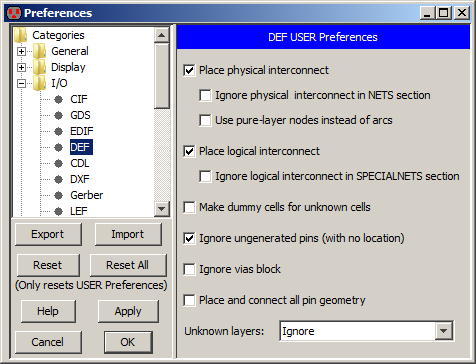7-3-5: LEF/DEF Control |
7-3-5: LEF/DEF Control |
| LEF options are controlled with the LEF Preferences (in menu File / Preferences..., "I/O" section, "LEF" tab). You can choose whether or not to ignore ungenerated pins. Ungenerated pins are those that have no location information, and are not fully part of the design. If they are not ignored (the box is unchecked) they are placed at the origin. You can choose what to do with unrecognized layers (either ignore them or use the DRC-exclusion layer). You can also ask Electric to ignore any technology information when reading the LEF file. |  |
 | DEF options are controlled with the DEF Preferences (in menu File / Preferences..., "I/O" section, "DEF" tab). This dialog controls whether DEF reads physical and/or logical information. If a type of interconnect is not checked, the DEF input reader ignores those arcs. |
DEF interconnect is specified in the NETS and SPECIALNETS sections. Typically, the SPECIALNETS are pre-routed geometry (physical) and the NETS are routed geometry (physical) or unrouted information (logical). Check "Ignore physical interconnect in NETS section" to skip any routed arcs (physical) found in the NETS section. Check "Ignore logical interconnect in SPECIALNETS section" to skip any unrouted arcs (logical) found in the SPECIALNETS section.
Physical NETS are read as arcs on different layers that connect the circuitry. This can take a lot of time to place. If it takes too long, and if the connectivity information is not needed, check "Use pure-layer nodes instead of arcs" to use pure-layer nodes instead of arcs.
When unknown cells are referenced by the DEF file, an error is issued. If "Make dummy cells for unknown cells" is checked, the system resolves the problem by generating the appropriate cell.
The "Ignore ungenerated pins (with no location)" option determines how to handle ungenerated pins. Ungenerated pins are those that have no location information, and are not fully part of the design. If they are not ignored (the box is unchecked) they are placed at the origin.
The "Ignore vias block" option causes vias to be dropped from import.
The "Place and connect all pin geometry" option connects like-named exports (called "pins" by Cadence) with unrouted arcs. Because Cadence systems give electrically-connected pins the same name, those like-named pins should all be connected. This option connects them in such a way that routers can wire them together.
Finally, you can control what happens to unrecognized layers (either ignore them or convert them to the DRC-exclusion layer).
| Previous | Table of Contents | Next |